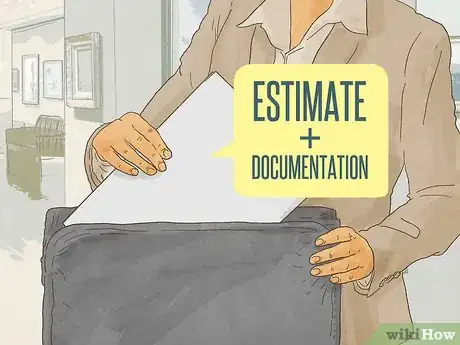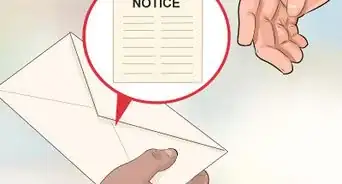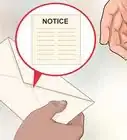This article was co-authored by Clinton M. Sandvick, JD, PhD. Clinton M. Sandvick worked as a civil litigator in California for over 7 years. He received his JD from the University of Wisconsin-Madison in 1998 and his PhD in American History from the University of Oregon in 2013.
wikiHow marks an article as reader-approved once it receives enough positive feedback. In this case, 84% of readers who voted found the article helpful, earning it our reader-approved status.
This article has been viewed 303,554 times.
When you suffer a bodily injury (personal injury) due to the negligence of another, you may have a claim against that other person for money damages. Whether you were injured in a car accident, a slip and fall scenario, or any other situation, you will want to know what the value of your injuries are. Knowing the value of your injuries will allow you to try to negotiate a fair and reasonable settlement as opposed to having to go to court. Follow the steps below in order to calculate the potential value of your personal injuries.
Steps
Estimating Your Potential Personal Injury Settlement Award
-
1Determine if you have an injury that is likely to result in a settlement award. If you are injured by someone else, you may have the ability to collect money damages in order to be compensated for your injury. In general, to be eligible to receive a personal injury award from the person who injured you, that person must have been negligent in their actions that caused your injury. Examples of potential negligence include car accidents, slip and fall incidents, work related injuries, injuries arising because of a defective product, and physical attacks. However, a person who injures you in one of these ways is not automatically negligent. In order to be negligent:
- A person must first owe a duty to you.[1] A duty arises when the law recognizes some sort of relationship between you and the person causing the injury.[2] For example, a driver of a vehicle on a public road may owe a duty to other drivers to drive reasonably under the circumstances.
- Second, the person who injured you must have breached the duty they owed to you.[3] A breach of duty arises when the person who injured you fails to exercise reasonable care in fulfilling their duty to you.[4] For instance, if a driver fails to act reasonably because he or she was driving too fast for the weather conditions, that driver may breach his or her duty when they hit and injure you while you are driving.
- Third, a person's actions must have caused your injuries.[5] Put another way, you have to be able to prove that but for the other person's actions, your injuries would not have occurred.[6] Using the same example as before, you would have to be able to prove that the only reason you were injured was because the other person was driving too fast for the road conditions.
- Finally, you must be able to prove damages. You must show that the other person's actions caused you actual harm.[7] Calculating these damages is what will be discussed the rest of this article.
-
2Add up all of your economic damages. Economic damages are the quantifiable damages stemming from objectively verifiable sources. Calculate your economic damages by adding together all of your bills and receipts you have for all of the different kinds of economic losses. These damages often include:
- Medical expenses;
- Property damage;
- Lost earnings;
- Future lost income; and
- Estimated future medical expenses.[8]
Advertisement -
3Use a multiplier to assess the extent of your general damages. General damages, often called non-economic damages, are the damages associated with subjective, non-monetary losses. In the legal world, this number is often formulated using your economic damages as a base.[9] You then multiply your economic damages by a number between 1.5 and 5 depending on the severity of your general damages.[10] The more severe and long-lasting your non-economic damages, the higher your multiplier will be.[11] Put another way, you are not monetizing your general damages, but instead quantifying the severity of your general damages in the nature of a multiplier. This process is subjective, use your best judgment when coming up with an acceptable multiplier. Types of general damages include:
- Pain and suffering;
- Inconvenience;
- Emotional distress;
- Loss of companionship; and
- Loss of enjoyment of life.
-
4Add together your total economic damages and general damages. After you have calculated your economic and general damages, you will add them together to get a grand total. This number represents the value of your personal injury claim so long as you did not contribute to your own injury and no punitive damages are considered.
- For example, if your economic damages include $4,000 in medical bills, $10,000 in property damage, $10,000 in lost earnings, and $6,000 in future lost earnings; and your non-economic damages are moderate to severe, meaning you estimate your multiplier at 3.5; and you did not contribute to your own injuries; then your estimated claim value would be $135,000 ($30,000 in economic damages + $105,000 in non-economic damages).
-
5Reduce your award calculation if your own actions contributed to the injury. If your carelessness contributes to your injuries, you may have to reduce the amount of your estimated recovery.[12] For example, you might contribute to your injuries if you were not wearing a seat belt when you were hit by another car, or if you were a pedestrian hit by a car but you were walking when there was a "no walk" sign on. The laws regarding how your contributions will affect your claims value will depend on the state your injuries occurred in.[13]
- If you live in a pure comparative negligence state (e.g., California or Florida), the dollar amount of your reward will be reduced by the percentage of your fault.[14] In the example above, your estimated claim value was $135,000. Now assume you were found to be 60% at fault. Your new estimated claim value would be $54,000 (60% of $135,000 is $81,000, which is subtracted from $135,000).
- If you live in a modified comparative negligence state (e.g., Iowa or Kansas), the dollar amount of your reward will be reduced by the percentage of your fault.[15] However, unlike a pure comparative negligence state, if you are found to be more than 50% at fault, you will not be able to win any damages.[16] In a modified comparative negligence state, if you were found to be 60% at fault, your estimated claim value would be $0. But assume you were found to be only 40% at fault. Your new estimated claim value would be $81,000 (40% of $135,000 is $54,000, which is subtracted from $135,000).
- Finally, if you live in a state following the rule of contributory negligence (e.g., Alabama or Virginia), if you are found to be even 1% at fault, you will not be able to recover at all.[17] In one of these states, if you were found to be even 1% at fault, your estimated claim value would drop from $135,000 to $0.
-
6Consider punitive damages. When the defendant's actions that caused your injury were particularly egregious, you may be able to increase the value of your estimated claim by considering punitive (exemplary) damages. Punitive damages are awarded to punish and deter a wrongdoer and are not awarded to compensate the victim.[18] If you believe your case qualifies for a potential punitive damage award, you should increase the value of your settlement offer.
- Punitive damages are awarded only by a jury or a judge and the amount available for recovery is often capped. Punitive damages cannot necessarily be calculated because of these factors, but if you believe you deserve them, discuss this fact during settlement negotiations and during trial and increase your estimated award value accordingly. Punitive awards can often be substantial, which means you may be able to increase your estimated award value substantially if the defendant's actions were egregious enough.
- For example, if you were injured by a collapsed roof, where the owner of the collapsed roof knew of the roof's potential for failure, and he or she consciously disregarded the danger, then you may be entitled to punitive damages.[19]
-
7Formulate a final estimated claim value based on your calculations. Once you have calculated your economic damages, your non-economic damages, your estimated percentage of fault, and the possibility of punitive damages, you can then estimate your total claim value. This is the number you will take with you to your settlement negotiations with the opposing party.
- Try using this calculator to formulate a final number. It will go through the same process described above.
- You can also contact an attorney specializing in personal injury cases and he or she can calculate your estimated total claim value. The attorney will ask you questions about your injuries and the scenario in which you received them, and will use that information to make his or her own calculation. Having an attorney may help to add legitimacy to your numbers, as this is part of the attorneys daily duties.
- Also, you can hire a professional to calculate your estimated claim value for you. There are a number of people who make a living as consultants working with attorneys and others coming up with these estimated claim values. If you are looking for one, try calling a personal injury attorney and ask if they have any recommendations.
Increasing the Value of Your Claim
-
1Document the accident. Documenting your injuries with pictures and written accounts is important. These cases can come down to small details like what shoes you were wearing and if they were untied. If you are injured, try to take pictures of the scene and write down as much as possible as soon as possible. However, do not risk injuring yourself more for the sake of documentation, as this may lead to a finding of comparative or contributory negligence. Document anything and everything you think may help you if a case should go to trial. This information can be used as leverage during your settlement negotiations. It can also help you quantify your economic and non-economic damages.
- Examples of valuable documentation include police reports, video footage, pictures taken from a phone, and medical reports.
-
2Talk to witnesses. Witnesses can help corroborate your story and add to your pile of documentation. Witnesses may have seen things from a different angle and may be able to tell you things about your injuries that you did not know (because you were in shock or maybe even unconscious). If the police are involved, get their police reports, which will usually include witness statements. You can also ask witnesses to write down their account of the accident and sign it. Also, ask them if they would be willing to be a witness in case there is a trial. Again, do not risk your personal health by finding or talking to witnesses. If you are too injured to do these things, do not do them.
-
3See a doctor. Seeing a doctor immediately after your injury may be one of the most important things you can do to document your injuries. Not only will a doctor's opinion provide you with leverage during settlement negotiations, the bills you receive from him or her will be a part of your economic damages. Do not wait to see your doctor as this may call into doubt the severity of your injuries and may even call into doubt whether you were injured at all. Keep records of all your diagnoses, referrals, prescriptions, and other things your doctor gives you.
Getting Your Award
-
1Hire an attorney. While it is not mandatory you hire your own attorney to help you through the judicial process, you may want to consider it. An experienced personal injury attorney will be able to help you maximize your potential award due to his or her negotiation skills, trial skills, and overall credentials. Hiring an attorney may be expensive, but it could be worth it in the long run.
-
2Start the judicial process. Once you have hired an attorney, and even if you are proceeding without one, you will have to either file a lawsuit or engage the opposing party in settlement talks. While every person has their own opinion on how to proceed, filing a lawsuit before engaging the opposing party in settlement talks can provide valuable leverage for you during negotiations. However, engaging in settlement talks before filing a lawsuit may help you and the opposing party stay out of a contentious legal battle and may provide an opening for friendlier settlement negotiations.
-
3Start settlement negotiations. To start the settlement negotiation process, reach out to the opposing party. Call the opposing party and tell them your situation and that you need to be compensated. If the opposing party has an attorney, call their attorney. If you have already started the judicial process, a judge may suggest that you try come to a settlement as well. Negotiating a settlement is advantageous for a number of reasons. Settling a case can save you money because you will not have to pay for an attorney to help you through a trial. Also, settling a case will save you time that you would otherwise have to spend going to court for months and possibly years. Finally, settling a case can provide you with a less risky alternative to trial, as you never know how a jury or a judge will assess your individual case.
-
4Bring your award estimate and documentation to the settlement discussions. During the settlement negotiations, there will likely be a number of important points of contention. It is important to have evidence and documentation showing why you chose the number you did. Doing so will help you get the settlement you want and will make it harder for your opposing party to disagree with you. The following are likely going to be your biggest points of contention:
- Your multiplier. Because this number is in large part subjective, it is going to a number that is going to get a lot of discussion. Having evidence of the severity of your non-economic losses will be important in order to agree on a multiplier that benefits you. Videos, doctor's notes, and psychiatric evaluations can all help.
- Your percentage of fault. During settlement negotiations, any percentage of fault the opposing party tries to attribute to you is simply an estimate. Only a judge or jury can place a definitive percentage of fault on you, which will not happen until a trial takes place. Because of this, avoid taking any initial blame for the injuries.[20] Wait for the other party to approach this issue.[21]
-
5Come to an acceptable agreement. Hopefully you and the other party can come to an acceptable agreement and you can avoid a trial. When you do so, you will hopefully get the award you deserve while avoiding the financial burden of a trial.
-
6Go to trial. If you are unable to reach a settlement with your opposing party, a trial may become necessary. Depending on where you were at in the judicial process when you started your settlement discussions, you may have to file a case or you may have to go back to your judge and tell him or her that you were unable to reach an agreement. Either way, at this point, you will have to begin preparing for the trial.
- Preparing for a trial can be a long process. Expect multiple interviews with a number of attorneys and other professionals and expect to have to give out a lot of personal information, including your medical records and mental health records. Hopefully, if you follow this article's directions, you will be awarded a fair settlement while avoiding the burdens of a trial.
Expert Q&A
-
QuestionShould you add up your medical bills before your insurance payments?
 Barzin Barry Sabahat, JDBarry Sabahat, Esq. has been practicing law in California since 1993. He received his JD from Western State University College of Law in 1992. His current practice is based in the San Francisco Bay Area and focuses on Estate Planning, Transactional Law and drunk driving cases.
Barzin Barry Sabahat, JDBarry Sabahat, Esq. has been practicing law in California since 1993. He received his JD from Western State University College of Law in 1992. His current practice is based in the San Francisco Bay Area and focuses on Estate Planning, Transactional Law and drunk driving cases.
Attorney at Law First, you should find a competent personal injury lawyer to help you. Insurance companies are notorious for low-balling unrepresented plaintiffs, so you may not get the payments you deserve if you do not have a lawyer. After you find a lawyer, get the insurance company involved as soon as possible. Keep all of your receipts. Keep copious notes of when you saw a doctor, what you told the doctor and what the doctor told you. Also, keep in mind that damages are more than just your medications and bills. You may also have pain and suffering, loss of income from having to miss work, and lots of other things.
First, you should find a competent personal injury lawyer to help you. Insurance companies are notorious for low-balling unrepresented plaintiffs, so you may not get the payments you deserve if you do not have a lawyer. After you find a lawyer, get the insurance company involved as soon as possible. Keep all of your receipts. Keep copious notes of when you saw a doctor, what you told the doctor and what the doctor told you. Also, keep in mind that damages are more than just your medications and bills. You may also have pain and suffering, loss of income from having to miss work, and lots of other things. -
QuestionWhat is the cap on attorney's fees for personal injury cases?
 Barzin Barry Sabahat, JDBarry Sabahat, Esq. has been practicing law in California since 1993. He received his JD from Western State University College of Law in 1992. His current practice is based in the San Francisco Bay Area and focuses on Estate Planning, Transactional Law and drunk driving cases.
Barzin Barry Sabahat, JDBarry Sabahat, Esq. has been practicing law in California since 1993. He received his JD from Western State University College of Law in 1992. His current practice is based in the San Francisco Bay Area and focuses on Estate Planning, Transactional Law and drunk driving cases.
Attorney at Law It depends on the type of case and your state. For example, in California, the attorney can charge based on a sliding scale for medical malpractice lawsuits. Before you sign on with an attorney, ask what he or she charges.
It depends on the type of case and your state. For example, in California, the attorney can charge based on a sliding scale for medical malpractice lawsuits. Before you sign on with an attorney, ask what he or she charges.
Warnings
- Never enter into a contract or settlement without consulting an attorney or understanding the language of the terms of the agreement.⧼thumbs_response⧽
- Remember, at this stage, prior to any trial, the percentage of your carelessness will be an estimate only. A judge or jury will ultimately be responsible for coming up with that percentage should you go to trial.⧼thumbs_response⧽
References
- ↑ http://images.findlaw.com/optimost/accident-injury-law/elements-of-a-negligence-case-2.html
- ↑ http://images.findlaw.com/optimost/accident-injury-law/elements-of-a-negligence-case-2.html
- ↑ http://images.findlaw.com/optimost/accident-injury-law/elements-of-a-negligence-case-2.html
- ↑ http://images.findlaw.com/optimost/accident-injury-law/elements-of-a-negligence-case-2.html
- ↑ http://images.findlaw.com/optimost/accident-injury-law/elements-of-a-negligence-case-2.html
- ↑ http://images.findlaw.com/optimost/accident-injury-law/elements-of-a-negligence-case-2.html
- ↑ http://images.findlaw.com/optimost/accident-injury-law/elements-of-a-negligence-case-2.html
- ↑ http://www.alllaw.com/articles/nolo/personal-injury/calculator.html
- ↑ http://www.alllaw.com/articles/nolo/personal-injury/calculator.html
- ↑ http://www.alllaw.com/articles/nolo/personal-injury/calculator.html
- ↑ http://www.alllaw.com/articles/nolo/personal-injury/calculator.html
- ↑ http://www.alllaw.com/articles/nolo/personal-injury/calculator.html
- ↑ http://www.alllaw.com/articles/nolo/personal-injury/calculator.html
- ↑ http://www.alllaw.com/articles/nolo/personal-injury/calculator.html
- ↑ http://www.alllaw.com/articles/nolo/personal-injury/calculator.html
- ↑ http://www.alllaw.com/articles/nolo/personal-injury/calculator.html
- ↑ http://www.alllaw.com/articles/nolo/personal-injury/calculator.html
- ↑ http://legal-dictionary.thefreedictionary.com/punitive+damages
- ↑ http://www.alllaw.com/articles/nolo/personal-injury/punitive-damages-gross-negligence.html
- ↑ http://www.alllaw.com/articles/nolo/personal-injury/calculator.html
- ↑ http://www.alllaw.com/articles/nolo/personal-injury/calculator.html
About This Article
How much you’re likely to get from a bodily injury settlement depends on your financial, psychological, and medical losses. Keep in mind you can only claim a settlement if someone had a duty of care over you and neglected their responsibilities. You’ll also have to prove the damage through things like medical bills and reports. To calculate your potential settlement, sum up your medical expenses, lost earnings, and future lost income due to your injury. Then, multiply this number by a factor between 1.5 and 5 depending on the severity of your pain, suffering, inconvenience, and loss of enjoyment of life. This is ultimately a subjective measure that will be decided by a judge and jury. However, your own evidence and testimony can help to substantiate this. For example, if you were bedbound for a month and suffered severe depression and anxiety, you could claim a higher settlement. For more tips from our Legal co-author, including how to start the process of getting your compensation, read on.







































































